TADF OLED emitters, or Thermally Activated Delayed Fluorescence, is a relatively new class of OLED emitter materials that promise efficient and long-lifetime performance without any heavy metals. TADF research started in earnest in 2012, and the first TADF emitters reached commercial status at the end of 2019.
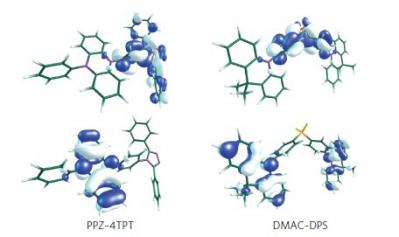
There are currently three main challenges with OLED emitters that TADF aims to solve - an efficient and long-lasting blue color emitter, low cost alternatives current red and green emitters and the development of soluble OLEDs that can be deposited using low cost ink-jet printing or other "wet" methods.
TADF is being developed by several companies. Japan-based Kyulux was established to commercialize Prof. Adachi's HyperFluoresence technology, which combines two emitter systems, TADF and Fluorescence. Germany-based Cynora is focusing on a blue TADF emitter. Both companies are working hard to achieve commercial-ready materials. While a blue TADF (or HyperFluoresence) emitter is not here yet, in late 2019 Kyulux and Wisechip brought to market the first OLED with a yellow HF emitter.
Idemitsu Kosan also considers TADF as one of the key OLED technologies and intends to focus on TADF in the future. In late 2019 Idemitsu together with Toray announced the world's most efficient red OLED emitter - based on Idemitsu's TADF/HF material. UDC has been recently awarded a patent on TADF materials, although the company says that TADF is not in its focus.
The EU launched two TADF related collaborative research projects to focus on TADF emitters, Project HyperOLED and the 2015 project Phebe.
The latest TADF news:
Densely-packaged dimer-enhanced MR-TADF emitters demonstrate high efficiency with a narrow emission spectrum
Researchers from Soochow University, in collaboration with a wide team of scientists from China and Japan (including Prof. Adachi from Kyushu University) developed a TADF emitter material compound that features high efficiency and a narrow color spectrum.
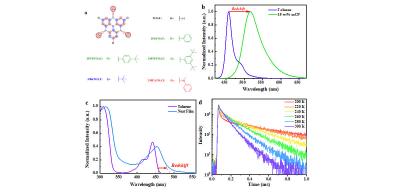
Up until now, most TADF emitters featured a wide spectrum, which limits the adoption of TADF materials in displays as they cannot enable a wide color spectrum. To overcome this problem companies employ a structure in which the TADF emitter is combined with a narrow-spectrum fluorescence emitter (so-called Hyperfluorescence).
Kyulux announces management changes
TADF OLED materials developer Kyulux announced a new CEO and President, to replace the current CEO Mr. Junji Adachi. Mr. Nakano will become the company's new CEO starting February 11, while Junji has been appointed as Chief Strategy Office. This is a part of a wide management change at Kyulux that reflects the company's transition from material development to commercialization.
Mr. Nakano has an impressive industry background in addition to management positions, and since 2014 he was an executive officer and manager director of Japan's Innovation Network (INCJ).
Cynora achieves breakthrough in its green TADF material, test kits are now available for display makers
OLED material developer Cynora announced that it achieved a breakthrough in its deep-green TADF material, which it brands as cyUltimateGreen. The new material delivers an efficiency of over 20% (EQE), a lifetime of 400 hours (LT95@15mA) and a color point and emission spectrum that matches today's DICI-P3 standard (Cynora does not specify the exact number).
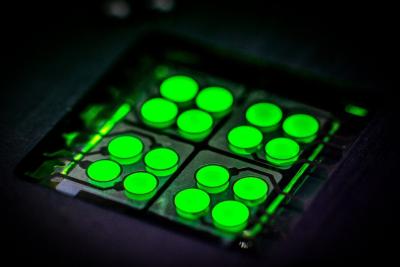
Cynora further announced that is now making test kits of the new deep-green emitter available to its customers. Display makers can now start testing and verification using the new material. Cynora says it will also 'soon' follow with a deep-blue TADF solution.
Researchers at Osaka University developed an efficient heavy-metal free room-temperature phosphorescence OLED emitter
Researchers from Osaka University developed the best performing heavy-metal-free room-temperature phosphorescence (RTP) OLED emitters.
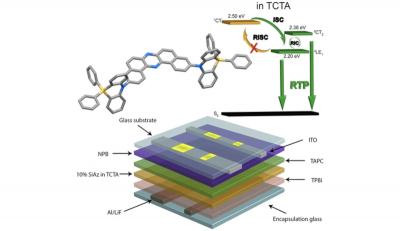
The researchers say that the new emitter (called SiAz), made entirely out of carbon, hydrogen, nitrogen, and silicon atoms, combines the mechanisms of TADF and RTP to create an efficient emitter system.
Kyushu University researchers developed a promising new two-unit stacked tandem Hyperfluorescence blue OLED emitter system
Researchers from Kyushu University reported that they have developed a promising new blue OLED emitter system, based on a two-unit stacked tandem hyperfluorescence OLED with improved singlet-excited-state energy transfer from a sky-blue assistant hetero-donor-type TADF (HDT-1) dopant.
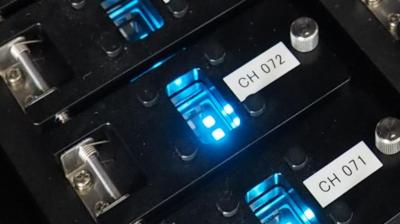
The research reports that the new emitter system offers a pure-blue color (CIE 0.13, 0.16), a narrow spectrum (full-width at half-maximum of 19 nm), an EQE of 32% at 1,000 cd/m2 and a lifetime of 18 hours LT95. The lifetime is still lacking, but with stricter control of device fabrication and procedures the researchers say they expect that device lifetimes will further improve to rival commercial fluorescent blue OLEDs.
SK Materials and JNC join forces to produce OLED stack materials
Korea-based SK Materials has established an OLED materials joint venture with Japan's JNC. The two companies will establish a new company called SK JNC (in which SK will hold 51%) that will produce OLED stack materials, including emitters.
The materials in production will be based on JNC's technologies and patents, including ones for blue emitters - apparently the main patent is for a TADF blue emitter. SK will provide its production and sales network.
Researchers develop an efficient near-infrared TADF OLED device
Researchers from Canada's Polytechnique Montréal and the Université de Montréal developed a new near-infrared (840 nm) TADF OLED device that is 300% more efficient than existing ones. The IQE of the new deice is 3.8% - which is the best all-organic OLED emitter ever developed above 800 nm.
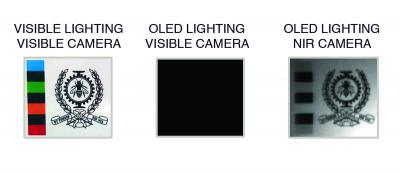
Photograph of the Polytechnique Montréal crest taken using visible and infrared illumination. Credit: Pr Sébastien Kéna-Cohen
To create the new OLED device, the researchers developed two new organic compounds - and were inspired by a class of molecules previously used for biomedical imaging.
Kyulux and Nippon Soda to co-develop intermediates for TADF emitters
TADF emitter developer Kyulux announced that has signed a joint-development agreement with Nippon Soda to develop new intermediates compounds for TADF emitters. The goal of this collaboration is to improve the performance and quality of Kyulux's TADF materials, and also dramatically improve the production efficiency of new compounds.

This agreement also markets Nippon Soda first entry into the OLED market. The company, founded in 1920, is highly environmentally conscious and has accumulated advanced organic material development capabilities and vast synthesis know-how, which will assist it in this new OLED project.
The 5th TADF Workshop to be held as an online live streaming event
Due to the global COVID-19 pandemic, the 5th annual International TADF Workshop and the 3rd i3-opera Forum, a companion event aimed at industry researchers, will be held on December 78 by means of online live streaming.
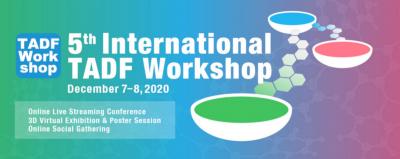
In the Workshop, novel scientific concepts will be discussed, as well as the future direction of TADF-OLEDs, perovskite LEDs, radical-based LEDs, QD-based LEDs, novel materials-based LEDs and more. In the Forum, the scope will be extended even further, to include topics ranging from TADF frontier science to interdisciplinary technologies for future lifestyle.
Eternal Material Technology starts to construct its 15-ton OLED material plant, updates on its OLED material and TASF project
China-based Eternal Material Technology (EMT) announced that it has started to construct its 15-tons OLED material production facility in Hefei. Yesterday the company held a groundbreaking ceremony at the construction site. EMT company expects the plant to begin mass producing materials in the second half of 2021. The planned total investment of the project (which will also include production of other materials) is 500 million yuan (or around $72 million USD).

EMT says that it has been able to achieve design wins for its ETL materials, and also other OLED related materials - and has already achieved sales of over 230 million Yuan ($33 million USD). EMT offers over 20 different OLED materials.
Pagination
- Previous page
- Page 4
- Next page





